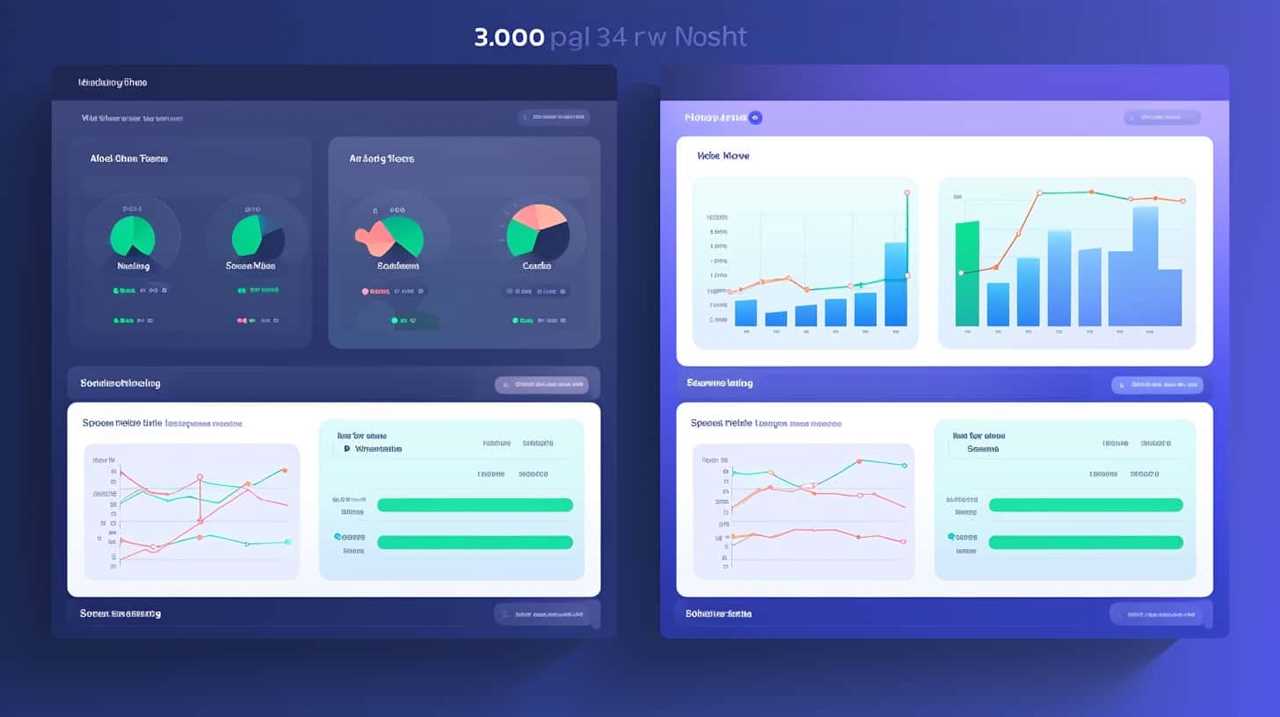I have always had a profound enthusiasm for managing sports teams and playing a role in their successes. Therefore, learning about how Google Ads can assist in attracting new participants and enhancing our team’s recognition was an exciting revelation for me.
With the right strategies, I’ve been able to score more goals than ever before. In this article, I’ll share my tried-and-true methods for using Google Ads effectively.
From setting clear goals to conducting effective keyword research, get ready to take your coaching game to the next level.
Key Takeaways
- Define clear goals and objectives for the Google Ads campaign to guide strategies and measure success.
- Conduct effective keyword research to improve ad targeting and give a competitive edge.
- Craft persuasive ad copy that highlights the unique benefits of coaching services and compels potential athletes to take action.
- Target the right audience and optimize landing pages to increase conversions and engage with potential supporters.
Understanding Google Ads for Sports Coaches
In this article, I’ll explain how I understand Google Ads and its relevance for sports coaches.

Understanding ad targeting and campaign optimization is crucial for coaches looking to maximize the effectiveness of their advertising efforts. Google Ads allows you to reach a specific audience by targeting keywords, interests, demographics, and geographic locations. This means that you can tailor your ads to reach potential athletes, parents, or even sponsors who are interested in your specific sports coaching services.
To effectively optimize your campaigns, it’s important to constantly analyze and adjust your targeting options. This involves monitoring the performance of your ads, identifying which keywords and demographics are generating the most engagement, and making data-driven decisions to improve your results.
Campaign optimization also includes testing different ad formats, headlines, and call-to-actions to see what resonates best with your target audience. By continuously refining your targeting and optimizing your campaigns, you can increase your chances of reaching the right people at the right time.
Now that we understand the basics of Google Ads and the importance of ad targeting and campaign optimization, let’s move on to the next section: setting clear goals for your advertising campaign.

Setting Clear Goals for Your Advertising Campaign
To start achieving success with Google Ads, I establish clear goals for my advertising campaign. Clear goal setting is crucial for any marketing strategy, as it allows me to focus on what I want to achieve and track my progress effectively. Here are the steps I follow to set clear goals for my Google Ads campaign:
- Define the objective: I start by identifying the main objective of my advertising campaign. Whether it’s increasing website traffic, generating leads, or boosting sales, having a clear objective helps guide my strategies and measure success.
- Set specific and measurable goals: I make sure to set specific goals that are quantifiable. For example, instead of saying I want to increase website traffic, I set a goal of increasing it by 20% within a specific timeframe. This not only provides a clear target but also allows me to track progress accurately.
- Break down goals into smaller milestones: Breaking down larger goals into smaller milestones helps me stay motivated and track progress more effectively. It also allows for adjustments and optimization along the way.
- Use data to track progress: Google Ads provides valuable data and metrics to track the progress of my advertising campaign. I regularly analyze these metrics to understand which strategies are working and where improvements can be made.
By setting clear goals and regularly tracking progress, I can optimize my Google Ads campaign and ensure it aligns with my overall marketing objectives.
Now, let’s move on to the next step: conducting effective keyword research.
Conducting Effective Keyword Research
I start by identifying relevant keywords that will effectively target my audience and maximize the success of my Google Ads campaign. Conducting effective keyword research is crucial for improving ad targeting and gaining an edge over competitors.

To begin, I brainstorm a list of keywords that are relevant to my sports coaching business. These could include terms like ‘sports coaching,’ ‘fitness training,’ or ‘athlete development.’
Once I’ve a list of potential keywords, I analyze competitor keywords to gain insights into what’s already working in the industry. By examining the keywords used by successful sports coaching businesses, I can identify gaps in the market and discover new opportunities. Tools like Google Ads Keyword Planner and SEMrush can be incredibly helpful in this process.
Analyzing competitor keywords also allows me to identify common themes and patterns. This knowledge helps me create more targeted ad campaigns that resonate with my audience. For example, if I notice that my competitors are using keywords related to youth sports coaching, I can tailor my ads to specifically target parents looking for coaching services for their children.
Creating Compelling Ad Copy
When it comes to creating compelling ad copy, I believe that the key lies in writing persuasive ads that captivate the attention of your target audience quickly.

By focusing on crafting clear and concise messages that highlight the unique benefits and value of your sports coaching services, you can effectively engage potential clients and entice them to take action.
Whether it’s through a compelling headline, a captivating description, or a strong call to action, your ad copy should aim to grab attention, generate interest, and ultimately drive conversions.
Writing Persuasive Ads
As a sports coach, my goal is to create persuasive ads that captivate and compel potential athletes to join our team. To achieve this, I employ the following strategies:
- Writing Persuasive Headlines: Crafting attention-grabbing headlines is crucial to pique the interest of potential athletes. By using strong, action-oriented language and highlighting the unique benefits of our team, we can draw them in and make them want to learn more.
- Optimizing Ad Targeting: Understanding our target audience is essential for writing persuasive ads. By conducting thorough market research and analyzing data, we can tailor our ads to reach the right people at the right time. This ensures that our message resonates with potential athletes and increases the likelihood of conversion.
- Highlighting Success Stories: Sharing success stories of current team members can be a powerful tool in persuading potential athletes to join. By showcasing the accomplishments and positive experiences of our team members, we can build trust and credibility, making it more compelling for others to join our team.
- Using Clear Call-to-Actions: Including a clear call-to-action in our ads is vital to guide potential athletes towards taking the desired action. Whether it’s signing up for a trial session or contacting us for more information, a strong and concise call-to-action motivates and directs potential athletes effectively.
Captivating Attention Quickly
To captivate attention quickly and create compelling ad copy, sports coaches can employ strategic techniques that engage potential athletes from the start. Improving engagement and enhancing user experience are crucial aspects of creating effective ads.

One way to achieve this is by using a well-crafted headline that sparks curiosity and intrigue. Additionally, incorporating strong visuals and compelling language can help grab the attention of the target audience.
Another technique is to highlight the unique benefits and features of the sports program or coaching services, emphasizing how they can help athletes achieve their goals. By focusing on what sets the program apart and addressing the needs and desires of potential athletes, coaches can create ad copy that resonates and compels them to take action.
Now, let’s explore the next important step: the call to action.
Call to Action
To create compelling ad copy, sports coaches should incorporate a strong call to action that motivates potential athletes to take the desired action. A well-crafted call to action can greatly improve conversion rates and optimize ad spend.

Here are four key strategies to consider:
- Use action-oriented verbs: Words like ‘join,’ ‘register,’ or ‘sign up’ create a sense of urgency and encourage immediate action.
- Highlight the benefits: Clearly communicate the value and benefits that athletes will gain by taking the desired action. This helps them understand why they should engage with your ad.
- Create a sense of scarcity: Limited-time offers or exclusive opportunities can create a sense of urgency and drive athletes to take action quickly.
- Provide clear instructions: Make it easy for potential athletes to follow through by providing clear and concise instructions on how to take the desired action.
Targeting the Right Audience for Your Team
My top priority as a sports coach is identifying the ideal audience for my team. To achieve this, I rely on audience segmentation and a targeted strategy. Audience segmentation allows me to divide potential supporters into distinct groups based on their demographics, interests, and behaviors. This helps me understand who my team’s most valuable fans are and how to effectively reach them.
Once I’ve segmented my audience, I can develop a targeting strategy to ensure my team’s message reaches the right people at the right time. By leveraging tools like Google Ads, I can tailor my advertisements to specific segments, such as age groups or geographic locations. This allows me to maximize the impact of my marketing efforts and connect with the fans who are most likely to engage with my team.
Now that I’ve identified my target audience, the next step is to optimize landing pages for maximum conversions. By creating landing pages that are visually appealing, easy to navigate, and compelling, I can increase the likelihood that visitors will take the desired action, whether it’s purchasing tickets, signing up for a newsletter, or joining a fan club.

Optimizing Landing Pages for Maximum Conversions
I optimize landing pages for maximum conversions by creating visually appealing, easy-to-navigate, and compelling pages that encourage visitors to take the desired action.
Here are four key strategies I employ for effective landing page optimization:
- Clear and concise messaging: I ensure that the headline and subheadings clearly convey the value proposition and key benefits of the product or service. This helps visitors quickly understand what they can gain by taking the desired action.
- Compelling visuals: I use high-quality images, videos, and graphics that are relevant to the product or service being offered. Visuals not only grab visitors’ attention but also help them visualize the benefits they can enjoy.
- Streamlined layout and navigation: I design landing pages with a clean and organized layout, making it easy for visitors to find the information they need. I use clear call-to-action buttons and minimize distractions to guide visitors towards the desired action.
- A/B testing and optimization: I constantly monitor and analyze the performance of different elements on the landing page, such as headlines, visuals, and call-to-action buttons. By testing and optimizing these elements, I strive to improve the conversion rate and maximize the effectiveness of the page.
By implementing these landing page optimization strategies, sports coaches can increase their chances of converting visitors into customers or sign-ups.
Now, let’s move on to the next section and discuss the importance of monitoring and analyzing campaign performance.

Monitoring and Analyzing Campaign Performance
Monitoring and analyzing campaign performance allows sports coaches to track the effectiveness of their Google Ads strategies. By regularly measuring and evaluating the performance of their campaigns, coaches can make data-driven decisions to optimize their advertising efforts. Two key aspects of monitoring and analyzing campaign performance are tracking conversions and analyzing audience demographics.
Tracking conversions is essential for determining the success of a Google Ads campaign. It involves identifying the desired actions that users take after clicking on an ad, such as making a purchase, filling out a form, or subscribing to a newsletter. By setting up conversion tracking in Google Ads, coaches can easily see how many conversions their campaigns are generating and which specific ads are driving the most conversions.
Analyzing audience demographics provides valuable insights into the characteristics of the individuals who are interacting with the ads. By understanding the age, gender, location, and interests of their target audience, coaches can tailor their messaging and targeting to better reach and engage potential customers. This data can also help coaches identify any gaps in their current marketing efforts and make adjustments accordingly.
To better illustrate the importance of monitoring and analyzing campaign performance, here is a table showcasing the metrics that coaches should pay attention to:

| Metric | Description | Importance |
|---|---|---|
| Click-through Rate | Percentage of users who click on the ad | Indicates ad relevance and appeal |
| Conversion Rate | Percentage of users who complete a desired action | Measures campaign effectiveness |
| Cost-per-Conversion | Average amount spent per conversion | Evaluates cost-efficiency of campaigns |
| Audience Demographics | Characteristics of the individuals interacting with the ads | Guides targeting and messaging strategies |
| Return on Investment | Ratio of revenue generated to ad spend | Assesses overall campaign profitability |
Implementing A/B Testing for Continuous Improvement
When it comes to optimizing Google Ads campaigns, A/B testing is a game-changer.
By testing different ad variations, I can determine which ones perform better and generate higher click-through rates.
This allows me to track performance metrics and make data-driven decisions to continuously improve my ads and achieve better results.
Testing Ad Variations
To implement continuous improvement in their Google Ads campaigns, sports coaches can test ad variations through A/B testing. This method allows coaches to compare different versions of their ads and determine which ones perform better in terms of conversion optimization.

Here are four steps coaches can follow to effectively test ad variations:
- Identify the variables: Start by identifying the specific elements of your ads that you want to test, such as headlines, call-to-actions, or images.
- Create variations: Develop different versions of your ads, making sure to change only one variable at a time to accurately measure its impact.
- Divide your audience: Split your audience into two groups, displaying one ad variation to each group.
- Measure and analyze results: Monitor the performance of each ad variation and compare the conversion rates to determine which version is more effective.
By testing ad variations, sports coaches can continuously refine their Google Ads campaigns and optimize conversions.
Now, let’s explore how tracking performance metrics can further enhance their strategies.
Tracking Performance Metrics
I track the performance metrics of my Google Ads campaigns to implement A/B testing for continuous improvement. Tracking ROI and measuring ad effectiveness are crucial for optimizing my campaigns and achieving better results. By analyzing the data, I can identify which ads are resonating with my target audience and driving conversions. This allows me to make data-driven decisions and allocate my budget effectively.

A/B testing plays a vital role in this process. By comparing different ad variations, I can determine which elements, such as headlines, images, or call-to-action buttons, are performing better. This helps me refine my ads and improve their overall effectiveness.
Constantly monitoring and analyzing performance metrics is essential for sports coaches, like me, who strive for mastery in their Google Ads campaigns.
Iterating for Better Results
How can I continuously improve my Google Ads campaigns as a sports coach?
One effective strategy is to implement A/B testing for continuous improvement. By conducting experiments and analyzing the results, you can optimize your targeting and maximize conversions. Here are four steps to help you get started:

- Define your goals: Clearly identify what you want to achieve with your Google Ads campaigns. Whether it’s increasing website traffic, generating leads, or boosting ticket sales, having clear goals will guide your testing process.
- Create variations: Develop different versions of your ads, landing pages, or targeting settings. Test changes in headlines, images, calls to action, or audience segments to see what resonates best with your target audience.
- Split your audience: Divide your audience into two groups and show each group a different variation of your campaign. This allows you to compare the performance of different elements and identify what works best.
- Analyze and iterate: Monitor the performance of each variation and analyze the data. Look for trends, patterns, and insights that can inform your decisions. Use the results to make informed changes and continuously optimize your campaigns for better results.
Implementing A/B testing can help you refine your Google Ads campaigns, improve targeting, and optimize conversions. By continuously iterating and experimenting, you can stay ahead of the competition and achieve greater success as a sports coach.
Utilizing Ad Extensions to Enhance Visibility
Ad extensions enhance the visibility of Google Ads, allowing sports coaches to reach a wider audience. By utilizing ad extensions, coaches can enhance their ad visibility and boost ad engagement. Ad extensions are additional pieces of information that can be added to your Google Ads, providing more context and enticing potential customers to click on your ad.
There are several types of ad extensions that sports coaches can utilize to enhance their visibility. One popular extension is the call extension, which allows coaches to include their phone number in their ads. This makes it easier for potential customers to contact you directly, increasing the chances of conversion.
Another effective ad extension is the sitelink extension. This allows coaches to include additional links to specific pages on their website, such as a registration page or a schedule of upcoming games. By providing these direct links, coaches can guide potential customers to the most relevant information, increasing the likelihood of them taking action.

Furthermore, coaches can also take advantage of the structured snippet extension. This extension allows coaches to highlight specific aspects of their services, such as the different types of training programs offered or the expertise of their coaching staff. By providing this additional information, coaches can better showcase their unique selling points and stand out from the competition.
Maximizing Return on Investment (Roi) With Budget Management
To maximize return on investment (ROI) with budget management, I prioritize analyzing campaign performance and adjusting spending accordingly. By closely tracking ROI and implementing effective budget optimization strategies, sports coaches can make the most of their advertising budget and achieve their goals.
Here are four key steps to maximize ROI through budget management:
- Set clear goals: Define your advertising objectives and establish measurable key performance indicators (KPIs) to track the success of your campaigns. This will help you determine the ROI you want to achieve and guide your budget allocation.
- Monitor campaign performance: Regularly review your ad performance metrics, such as click-through rates, conversion rates, and cost per acquisition. Identify high-performing campaigns and allocate more budget to them, while adjusting or pausing underperforming campaigns to save costs.
- Test and optimize: Continuously experiment with different ad formats, targeting options, and bidding strategies to find the most effective combination for your campaigns. Use A/B testing to compare different variables and make data-driven decisions to improve your ROI.
- Track ROI: Implement conversion tracking and attribution models to accurately measure the impact of your ads on your desired outcomes, whether it’s online purchases, lead generation, or website visits. This data will help you allocate your budget towards the most profitable campaigns.
By following these steps and staying up-to-date with Google Ads best practices, sports coaches can maximize their ROI and achieve their advertising goals.

Now, let’s discuss how staying informed about the latest Google Ads strategies can further enhance your success.
Staying Up-To-Date With Google Ads Best Practices
When it comes to staying up-to-date with Google Ads best practices, it’s crucial to keep an eye on the latest updates. By staying informed about the changes and new features, I can ensure that my campaigns are utilizing the most effective strategies.
Additionally, I need to regularly monitor key performance metrics to evaluate the success of my ads and make any necessary adjustments.
Latest Google Ads Updates
As a sports coach, staying up-to-date with the latest Google Ads updates is essential for maximizing the effectiveness of my advertising campaigns. Google Ads is constantly evolving, and keeping track of the latest updates ensures that I stay ahead of the game.

Here are some of the recent updates that I find particularly valuable:
- Ad targeting innovations: Google Ads now offers advanced targeting options, allowing me to reach my desired audience more precisely. From demographic targeting to custom intent audiences, these innovations help me tailor my ads to the right people at the right time.
- Performance measurement updates: Accurate measurement is crucial for assessing the success of my campaigns. Google Ads continues to introduce new performance measurement tools, such as attribution models and conversion tracking, enabling me to gain valuable insights into the effectiveness of my ads.
- Responsive search ads: Google Ads now supports responsive search ads, which automatically adjust the size and format of the ads to fit different devices. This increases the chances of my ads being seen by potential customers and improves overall ad performance.
- Smart bidding strategies: Google Ads has introduced smart bidding strategies, powered by machine learning, to help optimize my campaign’s performance. Whether it’s maximizing conversions or achieving target return on ad spend, these strategies automatically adjust bids to deliver the best results.
Staying up-to-date with these Google Ads updates allows me to leverage the latest tools and features, ultimately helping me score goals with my advertising campaigns.
Effective Campaign Strategies
Continuing with the advancements discussed in the previous subtopic, I find it crucial as a sports coach to stay up-to-date with effective campaign strategies and Google Ads best practices.
One key aspect of a successful campaign is effective ad targeting. This means identifying your target audience and tailoring your ads specifically to them. By understanding your audience’s demographics, interests, and online behavior, you can create ads that are more relevant and engaging, increasing the likelihood of conversion.

Another important strategy is conversion optimization. This involves analyzing and optimizing your campaign to maximize the number of conversions, whether it be sign-ups, purchases, or any other desired action. By constantly monitoring and adjusting your campaign based on data and performance metrics, you can improve its effectiveness and achieve better results.
Staying on top of these strategies and best practices ensures that your campaign is always optimized for success.
Monitoring Performance Metrics
To effectively monitor the performance metrics of my Google Ads campaigns, I regularly utilize quantifier determiners to track and analyze key data points. By tracking conversion rates and analyzing data, I’m able to gain valuable insights into the effectiveness of my campaigns and make informed decisions to optimize their performance.
Here are four important performance metrics that I closely monitor:

- Click-through Rate (CTR): This metric helps me gauge the relevance and effectiveness of my ads. A high CTR indicates that my ads are resonating with my target audience.
- Cost per Conversion (CPC): By tracking the cost per conversion, I can measure the efficiency of my campaigns and ensure that I’m getting the best return on investment.
- Conversion Rate: This metric allows me to see how many clicks are turning into actual conversions. By optimizing my landing pages and ad copy, I can improve this rate and increase my overall conversions.
- Return on Ad Spend (ROAS): ROAS helps me determine the profitability of my campaigns. By comparing the revenue generated with the amount spent on ads, I can assess the success of my advertising efforts.
Frequently Asked Questions
How Can I Track the Performance of My Google Ads Campaign?
I track the performance of my Google Ads campaign by analyzing campaign data and tracking conversions. It helps me understand which strategies are effective and make informed decisions to improve my campaign’s success.
What Are Some Effective Strategies for Optimizing Landing Pages?
Improving conversions and user experience are key strategies for optimizing landing pages. By focusing on clear messaging, compelling visuals, and easy navigation, I can create a seamless journey for visitors, increasing their likelihood of taking action.
How Can I Determine the Right Audience to Target for My Sports Team?
To determine the right audience for my sports team, I start by identifying demographics and analyzing my competitor’s audience. This helps me create targeted Google Ads that score goals by reaching the right people.
What Are Some Best Practices for Conducting A/B Testing With Google Ads?
When it comes to A/B testing with Google Ads, there are a few best practices to keep in mind. Testing different ad variations and landing pages is crucial for conversion optimization and improving overall campaign performance.

How Can I Enhance the Visibility of My Ads Using Ad Extensions?
To increase ad visibility, I use ad extensions techniques. By incorporating additional information like site links, callouts, and structured snippets, my ads stand out and reach a wider audience.
Conclusion
As sports coaches, we thrive on goals. And with Google Ads, we can score big in reaching our advertising goals.
By understanding Google Ads, setting clear goals, conducting effective research, creating compelling ad copy, targeting the right audience, implementing A/B testing, utilizing ad extensions, and maximizing ROI through budget management, we can stay ahead of the game.
So lace up your boots, because with the right strategies, you’ll be kicking winning goals with Google Ads in no time.










